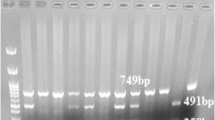Abstract
The TLRs gene encodes the principal innate immunity receptor in humans. The TLR2 Arg753Gln and Arg677Trp polymorphisms have been associated with a reduced response of monocytes and cell lines to challenge with mycobacteria. The TLR4 Asp299Gly and Thr399Ile polymorphisms have been associated with a reduction in the inflammatory responses to lipopolysaccharide in humans. It has been suggested that TLR2 and TLR4 polymorphisms may be associated with allergic responses; thus, we hypothesized that TLR2 and TLR4 polymorphisms may modify the relative risk for development of allergic rhinitis. The Taqman assay and high-resolution melt (HRM) were used for genotyping. We analyzed two single nucleotide polymorphisms (SNPs; 597T>C and 1350T>C) in the TLR2 gene and 1 SNP (4216G>C) in the TLR4 gene. We compared the genotype of these SNPs in patients with allergic rhinitis and controls without allergic rhinitis. We also estimated the haplotype frequencies between the two groups. The genotype and allele frequencies of the 597T>C and 1350T>C SNPs in the TLR2 gene were not significantly different between the patients with allergic rhinitis and controls (P > 0.05). The genotype and allele frequencies of 4216G>C in the TLR4 gene were not significantly different between the patients with allergic rhinitis and controls (P > 0.05). Haplotype analysis of the following two different (597)–(1350) major haplotypes (frequency >0.05) were present in the TLR2 gene: T–C and C–C. The C–C haplotype was positively associated with allergic rhinitis (P = 0.048). Our study suggests that the TLR2 gene polymorphisms might be susceptible to the development of allergic rhinitis. Further functional studies of TLR2 genetics in light of the associations with allergic rhinitis inflammation would help clarify the role of TLR2 genetics in clinical evaluations.
Similar content being viewed by others
References
Arbour NC, Lorenz E, Schutte BC, Zabner J, Kline JN, Jones M, Frees K, Watt JL, Schwartz DA (2000) TLR4 mutations are associated with endotoxin hyporesponsiveness in humans. Nat Genet 25:187–192
Cook DN, Pisetsky DS, Schwartz DA (2004) Toll-like receptors in the pathogenesis of human disease. Nat Immunol 5:975–979
Eder W, Klimecki W, Yu L, von Mutius E, Riedler J, Braun-Fahrländer C, Nowak D, Martinez FD (2004) Toll-like receptor 2 as a major gene for asthma in children of European farmers. J Allergy Clin Immunol 113:482–488
Fransson M, Adner M, Erjefalt J, Jansson L, Uddman R, Cardell LO (2005) Up-regulation of toll-like receptors 2, 3 and 4 in allergic rhinitis. Respir Res 6:100
Hamann L, Hamprecht A, Gomma A, Schumann RR (2004) Rapid and inexpensive real-time PCR for genotyping functional polymorphisms within the Toll-like receptor -2,-4, and -9 genes. J Immunol Methods 285:281–291
Kormann MSD, Depner M, Hartl D, Klopp N, Illig T, Adamski J, Vogelberg C, Weiland SK, von Mutius E, Kabesch M (2008) Toll-like receptor heterodimer variant protect from childhood asthma. J Allergy Clin Immunol 122:86–92
Medzhitov R, Janeway C Jr (2000) The Toll receptor family and microbial recognition. Trends Microbiol 8:452–456
Nuguchi E, Nishimura F, Fukai H, Kim J, Ichikawa K, Shibasaki M, Arinami T (2004) An association study of asthma and total serum IgE levels for Toll-like receptors polymorphisms in the Japanese population. Clin Exp Allergy 34:177–183
Raby BA, Klimecki WT, Laprise C, Renaud Y, Faith J, Lemire M, Greenwood C, Weiland KM, Lange C, Palmer LJ, Lazarus R, Vercelli D, Kwiatkowski DJ, Silverman EK, Martinez FD, Hudson TJ, Weiss ST (2002) Polymorphisms in toll-like receptor 4 are not associated with asthma or atopy-related phenotypes. Am J Respir Crit Care Med 166:1449–1456
Romagnani S (2004) The increased prevalence of allergy and the hygiene hypothesis: missing immune deviation, reduced immune suppression, or both? Immunology 112:352–363
Strachan DP (2000) Family size, infection and atopy: the first decade of the “hygiene hypothesis”. Thorax 55(Suppl):S2–S10
Tulic MK, Fiset PO, Manoukian JJ, Frenkiel S, Lavigne F, Eidelman DH, Hamid Q (2004) Role of toll-like receptor 4 in protection by bacterial lipopolysaccharide in the nasal mucosa of atopic children but not adults. Lancet 363:1689–1697
Vasselon T, Detmers PA, Charron D, Haziot A (2004) TLRs recognizes a bacterial lipopeptide through direct binding. J Immunol 173:7401–7405
Weidinger S, Novak N, Klopp N, Baurecht H, Wagenpfeil S, Rummler L, Ring J, Behrendt H, Illig T (2006) Lack of association between Toll-like receptor 2 and Toll-like receptor 4 polymorphisms and atopic eczema. J Allergy Clin Immunol 118:277–279
Yang IA, Barton SJ, Rorke S, Cakebread JA, Keith TP, Clough JB, Holgate ST, Holloway JW (2004) Toll-like receptor 4 polymorphism and severity of atopy in asthmatics. Genes Immun 5:41–45
Yang LA, Fong KM, Holgate ST, Holloway JW (2006) The role of Toll-like receptors and related receptors of the innate immune system in asthma. Curr Opin Allergy Clin Immunol 6:23–28
Zhou LF, Yin KS (2004) Toll-like receptors: function and roles in asthma. Chin Med J (Engl) 117:1709–1715
Acknowledgments
This work was supported by a grant from the Korea Health 21 R&D Project by the Ministry of Health and Welfare (A010251).
Author information
Authors and Affiliations
Corresponding author
Additional information
I. Kang and Y.-K. Oh contributed equally to this paper.
Rights and permissions
About this article
Cite this article
Kang, I., Oh, YK., Lee, S.H. et al. Identification of polymorphisms in the Toll-like receptor gene and the association with allergic rhinitis. Eur Arch Otorhinolaryngol 267, 385–389 (2010). https://doi.org/10.1007/s00405-009-1100-y
Received:
Accepted:
Published:
Issue Date:
DOI: https://doi.org/10.1007/s00405-009-1100-y




